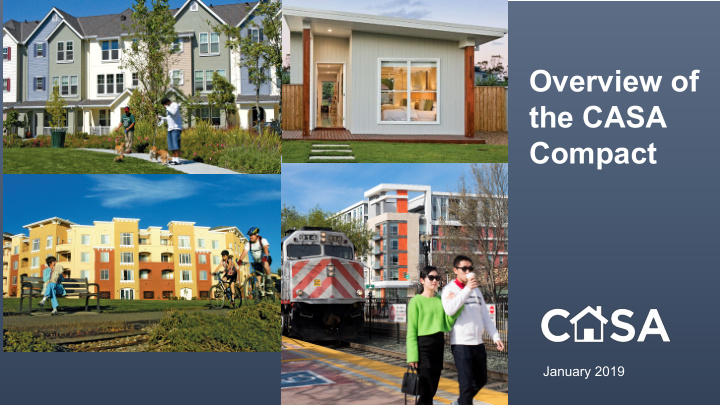



Overview of the CASA Compact January 2019
The Bay Area faces a housing crisis because we have failed at three tasks: • Failed to produce enough housing for residents of all income levels • Failed to preserve existing affordable housing • Failed to protect current residents from displacement
3 Three Co-Chairs CBO Outreach Technical Steering Committee Committee 32 members 18 members Local Jurisdiction Work Groups Outreach Production Protection Preservation
4 Components of Compact: 15-year housing emergency bills 9-County Bay Area • Elements 1, 2 & 3: Protection • Element 4: Remove Barriers to ADUs • Elements 5, 6 & 7: Production Initiatives • Element 8: Surplus Public Land • Element 9: Potential Funding Sources • Element 10: Regional Housing Enterprise
5 • Ensure Bay Area tenants are protected from arbitrary evictions by adopting region-wide requirement landlords cite specific "just causes" (fault and no-fault) for evictions, e.g. failure to pay rent, violating lease. Reference: State-wide New Jersey “Anti-Eviction Act” since 2008
6 • Establish Bay Area-wide emergency rent cap that limits annual rent increases to reasonable amount in order to decrease number of households at risk of displacement and to prevent homelessness. • Covers existing buildings AND new construction • Local rent control programs supercede State standards • For emergency period (15 years), CPI+5% in any one year with certain exemptions and banking provision.
7 • For low-income tenants facing eviction: access to free legal counsel and emergency rent assistance for tenants with an urgent, temporary financial gap. • Regional Housing Enterprise (Element #10) would establish policy guidelines and provide funding for programs.
8 • Extend current Bay Area best practices on Accessory Dwelling Units (ADUs) and Junior ADUs to all jurisdictions in the region. • Allow an ADU and a Junior ADU on single family lots and multiple ADUs in existing multi-family buildings with ministerial approval—enable modular market • Require impact fees for ADUs and tiny homes be charged on a per-square foot basis and only on net new living area above 500 sq. ft.
9 • Establish minimum zoning for housing in neighborhoods with: High quality bus service – within ½ mile of stop, “missing middle” zoning-to 36 ft. Major transit stop (rail and ferry stations) – within ¼ mile, allow up to 55 ft. • Make housing an eligible use on large, commercially-zoned parcels near job centers and in areas served by high quality transit. • For “sensitive communities” in or adjacent to a major transit stop, defer height increases above 36 ft. until jurisdiction develops community plan.
• Upzoning in Sensitive Community Areas (outlined in red) within ¼ -mile of Major Transit Stop (rail/ferry) is limited to 36’ for five years. • High quality bus service areas are shown in orange and limited to East Bay, San Jose and S.F.
11 • Establish ‘good government’ standards for entitlement and permitting of zoning-compliant residential projects, including but not limited to: - Local agencies must transparently publish all rules, codes, fees, impositions, and standards for residential applications. - Rules, fees and historic designation locked at an application’s completeness determination. - Limit of 3 de novo public hearings & 12 months for approvals - No “double burden” (cannot add IZ, density bonus, impact fees) -Transparent impact fee methodology and reporting
12 • Accelerate CEQA and discretionary approval of zoning-compliant projects that provide on-site affordability for “missing middle” (restrict >20% units to 80-150% AMI), pay prevailing wage and use apprentice labor. • Incentives offered to offset higher costs to developer: • 15 years of property tax increment abatement, modeled on NYC program, aimed at missing middle incomes • Impact fees capped at a reasonable level • Density bonus of 35% • Parking minimums reduced to 50% of local requirement
13 • Promote increased utilization of public land for affordable housing through variety of legislative and regulatory changes, as well as the creation of new regional coordination and planning functions.
14 • Raise $1.5 billion/year in new revenue from a broad range of sources, including property owners, developers, employers, local governments and the taxpayers, to fund implementation of the CASA Compact.
Menu of Funding Sources to Implement the Compact Potential New Sources of Revenue Target: $1.5 billion per year Local Property Owners Developers Employers Taxpayers Governments $100 million $200 million $200 million $200 million $400 million 1 percent Variable Commercial 0.1%-0.75% 25 percent 1/4-cent Vacant Homes Tax Linkage Fee Gross Receipts Tax Redevelopment Regionwide Sales Tax on the assessed value ($5-$20 per sq. ft.) variable rates based on Revenue Set-Aside of vacant home on new construction sector and firm size for affordable housing $100 million with rate varied in TPAs (including 5-Yr. Term depending on location portion for schools and $100 million General Obligation to incentivize infill special districts) Bonds $48 per year $200 million development issued by a regional Regionwide Parcel Tax $40-120 per job housing enterprise, $200 million Head Tax $100 million renewed every five Flat Commercial variable rates based on 20 percent years Philanthropy Linkage Fee number of employees, Revenue Sharing ( $10 per sq. ft) Contribution jobs-housing ratio and on new construction transit access from future property tax Chan-Zuckerberg- growth SF Foundation Initiative Policy and Infrastructure Funds 15
16 • Establish a regional leadership entity to fund affordable housing and all elements of the CASA Compact, track and report progress, and provide incentives and technical assistance to local government. • It would not have direct land use/zoning authority, eminent domain powers, or play a regulatory enforcement role.
Redevelopment 2.0 Lower voter threshold for funding ballot measures Fiscalization of Land Use and Tax Reform Homelessness Grow and Stabilize the Construction Labor Force
CASA Work Windows 2018 2019 2020 2021 2022 CASA Legislative Election #1 PBA/RHNA Election #2 Development Package Presidential Adoption Gubernatorial 18
Recommend
More recommend